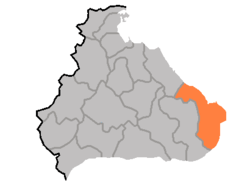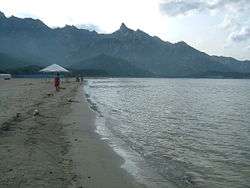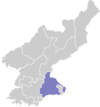Kosong County
Kosŏng County ([ˈkɤsɔŋ‿ɡun]) is a kun, or county, in Kangwŏn province, North Korea. It lies in the southeasternmost corner of North Korea, immediately north of the Korean Demilitarized Zone. Prior to the end of the Korean War in 1953, it made up a single county, together with what is now the South Korean county of the same name. In a subsequent reorganization, the county absorbed the southern portion of Tongch'ŏn county.
Kosŏng County 고성군 | |
|---|---|
| Korean transcription(s) | |
| • Chosŏn'gŭl | 고성군 |
| • Hancha | 高城郡 |
| • McCune-Reischauer | Kosŏng-gun |
| • Revised Romanization | Goseong-gun |
 Map of Kangwon showing the location of Kosong | |
| Country | North Korea |
| Province | Kangwŏn Province |
| Administrative divisions | 1 ŭp, 23 ri |
Physical features

Kosŏng is largely mountainous, but there is flat land along the coast of the Sea of Japan (East Sea of Korea) to the county's east. The mountains here are part of the Taebaek range. A portion of Kŭmgangsan mountain is included in the county.
Administrative divisions
Kosŏng county is divided into 1 ŭp (town) and 23 ri (villages):
|
|
Economy
The local economy is dominated by agriculture, although fishing also plays a role, together with the harvesting of brown seaweed and clams. Significant local crops include rice, maize, soybeans, wheat, and barley. It is particularly well known as a source for bamboo handicrafts.
Transport
- Rail
Nearly half the length of the Kŭmgangsan Ch'ŏngnyŏn line of the Korean State Railway is in Kosŏng county. It is operational as far south as Kŭmgangsan Ch'ŏngnyŏn Station. From there. the line continues south to Samilp'o and Kamho stations (both in North Korea, but not in regular use), thence across the DMZ to connect to Korail's Tonghae Pukpu line at Jejin.[1]
The section between Kŭmgangsan Ch'ŏngnyŏn and Jejin stations was out of service from the partition of Korea until 2007, when it was reopened for passenger trains from the South to the Mount Kŭmgang Tourist Region; it was closed again after the shooting of a South Korean tourist by a KPA soldier.[2]
- Sea
The nearest major port is Wŏnsan.
References
- Kokubu, Hayato, 将軍様の鉄道 (Shōgun-sama no Tetsudō), ISBN 978-4-10-303731-6
- ROK woman tourist shot dead at DPRK resort. China Daily. July 12, 2008
External links
- (in Korean) In Korean language online encyclopedias:
